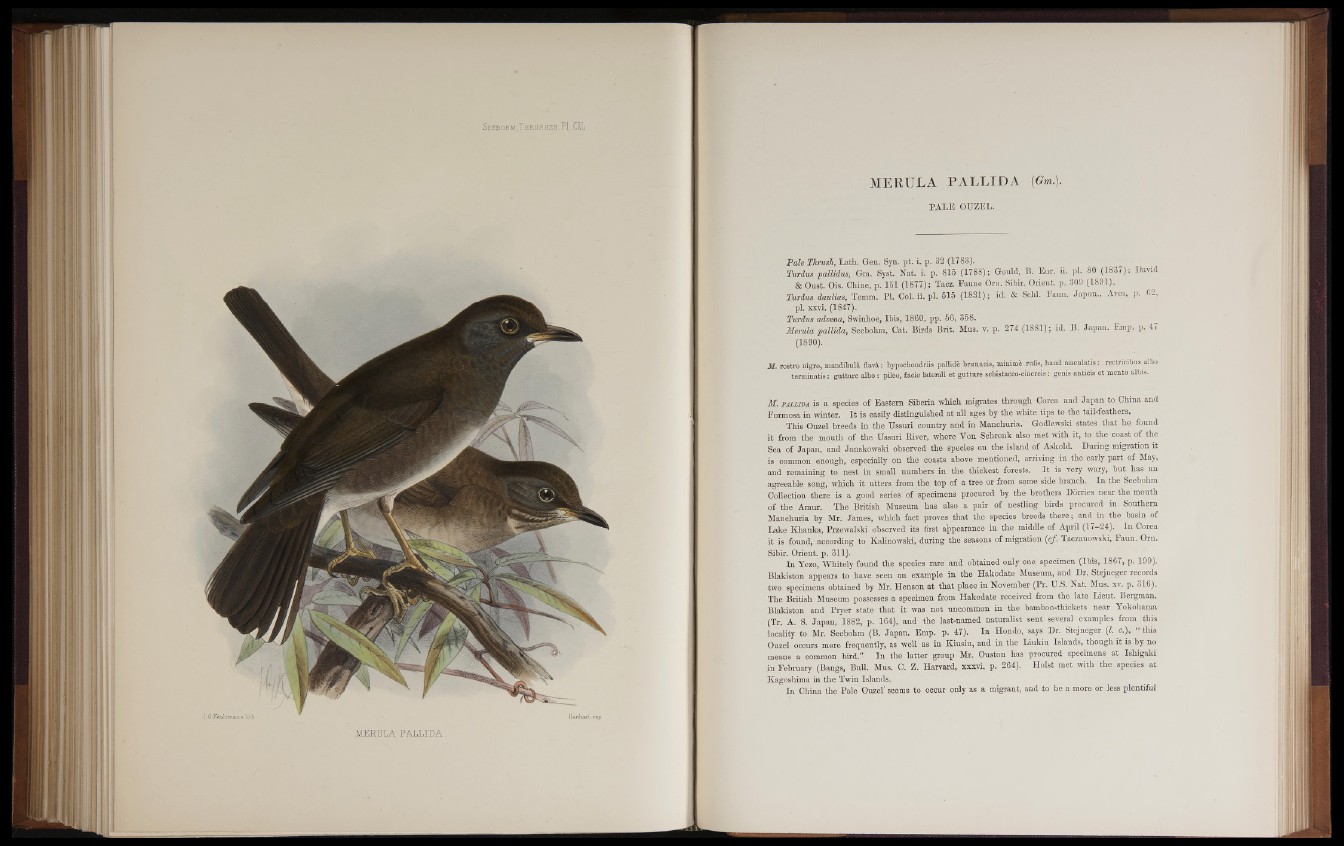
MERULA P A L L ID A {Gm.).
PALE OUZEL.
Pale Thrush, Lath. Gen. Syn. pt. i. p. 32 (1783).
Turdus pallidus, Gm. Syst. Nat. i. p.. 815 (1788); Gould, B. Eur. ii. pi. 80 (1837); David
& Oust. Ois. Chine, p. 151 (1877); Tacz. Faune Oru. Sibir. Orient, p. 309 (1891).
Turdus daulias, Temm. PI. C o l.ii.p l. 515 (1831); id. & Schl. Faun. Japon., Aves, p. 02,
pl. xxvi. (1847).
Turdus advena, Swinhoe, Ibis, 1860, pp. 56, 358-
Merula pallida, Seebohm, Cat. Birds Brit. Mus. v. p. 274 (1881); id. B. Japan. Emp. p, 47
(1890).
M. rostro nigro, mandibulit flavS,: hypochondriis pallide brunneis, minime rufis, haud maculatis: rectricibus. allio
terminatis: gutture a lb o : pileo, facie laterali et gutture schistaceo-cinereis: genis anticis e t mento albis.
jM. p a l l id a is a species of Eastern Siberia which migrates through Corea and Japan to China and
Formosa in winter. I t is easily distinguished at all ages by the white tips to the tail-feathers.
This Ouzel breeds in the Ussuri country and in Manchuria. Godlewski states that he found
it from the mouth of the Ussuri River, where Yon Schrenk also met with it, to the coast of the
Sea of Japan, and Janskowski observed the species on the island of Askold. During migration it
is common enough, especially on the coasts above mentioned, arriving in the early part of May,
and remaining to nest in small numbers in the thickest forests. I t is very wary, but has an
agreeable song, which it utters from the top of a tree or from some side branch. In the Seebohm
Collection there is a good series of specimens procured by the brothers Dorries near the mouth
of the Amur. The British Museum has also a pair of nestling birds procured in Southern
Manchuria by Mr. James, which fact proves that the species breeds th e re ; and in the basin of
Lake Khanka, Przewalski observed its first appearance in the middle of April (17-24). In Corea
it is found, according to Kalinowski, during the seasons of migration ( e f Taczanowski, Faun. Orn.
Sibir. Orient, p. 311).
In Yezo, Whitely found the species rare and obtained only one specimen (Ibis, 1867, p. 199).
Blakiston appears to have seen an example in the Hakodate Museum, and Dr. Stejneger records
two specimens obtained by Mr. Henson at that place in November (Pr. U.S. Nat. Mus. xv. p. 316).
The British Museum possesses a specimen from Hakodate received from the late Lieut. Bergman.
Blakiston and Pryer state that it was not uncommon in the bamboo-thickets near Yokohama
(Tr. A. S. Japan, 1882, p. 164), and the last-named naturalist sent several examples from this
locality to Mr. Seebohm (B. Japan. Emp. p. 47). In Hondo, says Dr. Stejneger (L <?.), “ this
Ouzel occurs more frequently, as well as in Kiusiu, and in the Liukiu Islands, though it is by no
means a common bird.T In the latter group Mr. Ouston has procured specimens at Ishigaki
in February (Bangs, Bull. Mus. C.. Z. Harvard, xxxvi. p. 264). Holst met with the species at
Kagoshima in the Twin Islands.
In China the Pale Ouzel' seems to occur only as a migrant, and to be a more or less plentiful